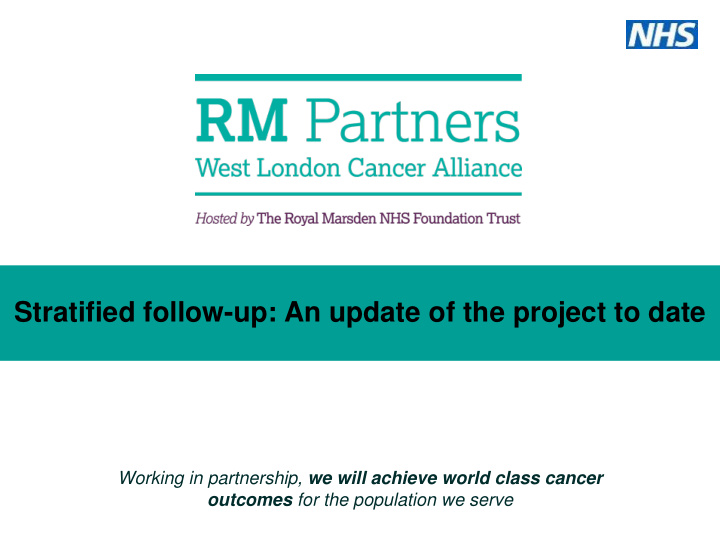



Stratified follow-up: An update of the project to date Working in partnership, we will achieve world class cancer outcomes for the population we serve
Rationale 2
RM Partners, West London Cancer Alliance – Hosted by The Royal Marsden Hospital NHS Foundation 3 Trust
• Developing clinical service evaluation • NHS Operational Planning Guidance mandated • Building on existing FU models RM Partners, West London Cancer Alliance – Hosted by The Royal Marsden Hospital NHS Foundation 4 Trust
Developing a baseline 5
Review of: • National guidance • Regional Models • Different tumour sites • Local follow-up provision RM Partners, West London Cancer Alliance – Hosted by The Royal Marsden Hospital NHS Foundation 6 Trust
Name of Trust Eligibility Clinical SOP Treatment Remote Support Introduction Patient GP Patient SFU Nurse Criteria Management Summary Monitoring Worker to SSMFU Information Information Portal led Protocols letter ✖ ✖ ✖ ✖ ✖ ✖ ✖ ✖ ✖ ✖ ✖ ✔ ✔ ✔ ✔ ✔ ✔ ✔ ✔ ✔ ✖ ✔ ✖ ✖ ✖ ✖ ✖ ✖ ✖ ✖ ✖ ✖ ✖ ✔ ✖ ✖ ✔ ✖ ✖ ✖ ✔ ✔ ✖ ✔ ✔ ✖ ✔ ✔ ✔ ✔ ✖ ✔ ? ? ✔ ✖ ✔ ✖ ✖ ✔ ✔ ✖ ✔ ? ? ✔ ✔ ✔ ✖ ✖ ✔ ✔ ✖ ✔ ? ? ✔ ✔ ✔ ✔ ✔ ✔ ✔ ✔ ✔ ✖ ✔ ✔ ✖ ✔ ✔ ✔ ✔ ✔ ✔ ✖ ✔ ? RM Partners, West London Cancer Alliance – Hosted by The Royal Marsden Hospital NHS Foundation 7 Trust
Model development 8
• Proposed model developed via an iterative co-development process • Ensuring robust systems for the management of surveillance are established • Cancer Alliance-wide meeting to agree model RM Partners, West London Cancer Alliance – Hosted by The Royal Marsden Hospital NHS Foundation 9 Trust
SFU: Breast Model Core components: • Professional-led pathway for all breast cancer pathways • Supported self-management pathway for Early Breast Cancer patients • Embed needs assessment and care-planning for all patients at the end of treatment • Ensure all patients and their GPs are provided with a Treatment Summary after completing treatment • Process for clinician-patient review to determine and agree transition to supported self-management pathway • Provision of supported self-management and health and well-being information • Surveillance protocol, with process for scheduling and monitoring investigations • Process for patients to access support and advice • Recall process for abnormal surveillance investigations and change in patient-reported symptoms • Clinically-led review of patients 5 years after treatment to review adjuvant treatment regime and discharge from secondary care-led follow-up • Clinical appointment for patients requiring extended treatment regimes • Process for discharge of patients to GP at 5 years 10
Breast follow-up Current Model Proposed Model Conventional Model Indicative timeline Clinical Review ▪ Needs assessment ▪ Care plan MDT clinical review ▪ Treatment summary Active MDT clinical review treatment complete Not eligible Professional- Patient eligibility Continue led pathway assessment annual FU End of treatment appointment Supported self- Rehabilitation 6- 12 Dissemination of OAFU management patient information weeks pathway Completion of HNA, care completion of HNA, Follow up: post OAFU appointment plan and dissemination of ▪ Consultant care plan and treatment treatment summary led dissemination of Patient ▪ AHP/Nurse treatment summary Provision of tracking Specialist led supported-self system Abnormal Abnormal management and result result health and Surveillance Patient Surveillance Patient recalled wellbeing recalled <2 <2 weeks information weeks Patient Annually Normal result concerns Normal result Patient re- Patient OPA access specialist Recall Surveillance Support Helpline triage service if process protocol and advice required Discharge to Discharge to Primary MDT Clinical review OAFU Virtual MDT Primary Care Care Clinically-led review: discharge from 5 years surveillance Extended post Extended therapy therapy required treatment required Discharge to GP Discharge to primary with information care for on-going Continue annual for on-going monitoring OPA monitoring 11
Conventional Model • Traditional model – medically led Current Model • Incorporates Professional led and Open Access Follow-Up (OAFU) pathways • OAFU introduced in 2014 Proposed Model • Incorporates professional led and supported-self management (SSM) pathways • Working towards embedding HNAs and Treatment Summaries to address unmet needs • Exploring new delivery models for SSM information and patient facing support worker roles 12
Implementation 13
• Focussed clinical and operational support dedicated to the project • Senior management sponsorship across all organisations • Core components agreed at Alliance level with ability to flex the model depending on individual site requirements • Exploring new ways of working: supported-self management workshop • Development of Trust standard operating procedures and processes • Examining barriers in completing Treatment Summaries, needs assessments and care plans • Standardising patient and GP documentations • Standardising bone health management guidelines 14
Recommend
More recommend